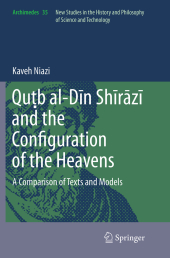 Neuerscheinungen 2016Stand: 2020-02-01 |
Schnellsuche
ISBN/Stichwort/Autor
|
Herderstraße 10
10625 Berlin
Tel.: 030 315 714 16
Fax 030 315 714 14
info@buchspektrum.de |

Kaveh Niazi
Qu b al-Din Shirazi and the Configuration of the Heavens
A Comparison of Texts and Models
Softcover reprint of the original 1st ed. 2014. 2016. xiii, 189 S. 30 SW-Abb. 235 mm
Verlag/Jahr: SPRINGER NETHERLANDS; SPRINGER 2016
ISBN: 9402400826 (9402400826)
Neue ISBN: 978-9402400823 (9789402400823)
Preis und Lieferzeit: Bitte klicken
This book provides a detailed biography of Qu b al-Din Shirazi, a leading scientist of the 13th century, and clarifies the relationship between his three well-known, but little studied, medieval works on astronomy.
As a leading scientist of the 13th century C. E. Qu b al-Din Shirazi wrote three substantial works on hay´a (or the configuration of the celestial orbs): Nihayat al-idrak fi dirayat al-aflak ("The Limits of Attainment in the Understanding of the Heavens"), al-Tuhfa al-shahiya fi ´ilm al-hay´a ("The Royal Offering Regarding the Knowledge of the Configuration of the Heavens"), and Ikhtiyarat-i Mu affari ("The Mu affari Elections"). Completed in less than four years and written in two of the classical languages of the Islamic world, Arabic and Persian, these works provide a fascinating window to the astronomical research carried out in Ilkhanid Persia. Shirazi and his colleagues were driven by their desire to rid Ptolemaic astronomy from its perceived shortcomings. An intriguing trail of revisions and emendations in Shirazi´s hay´a texts serves to highlight both those features of Shirazi´s astronomy that were inherited from his predecessors, as well as his original contributions to this branch of astronomical research. As a renowned savant, Shirazi spent a large portion of his career near centers of political power in Persia and Anatolia. A study of his scientific output and career as a scholar is an opportunity, therefore, for an examination of the patronage of science and of scientific works within the Ilkhanid realms. Not only was this patronage important to the work of scholars such as Shirazi but it was critical to the founding and operation of one of the foremost scientific institutions of the medieval Islamic world, the Maragha observatory. The astronomical tradition in which Shirazi carried out his research has many links, as well, to the astronomy of Early Modern Europe, as can be seen in the astronomical models of Copernicus.
Acknowledgement.- Note on Transliteration.- Chapter 1. Purpose and Background of Study.- Chapter 2. The Mongols in Iran.- Chapter 3. Shirazi´s Life.- Chapter 4. The Principal Astronomical Sources.- Chapter 5. Persian vs. Arabic: Language as a Determinant of Content.- Chapter 6. Conclusion.- Figures- Bibliography.- Appendix A.- Appendix B.- Appendix C.- Appendix D.- Appendix E.- Index.


